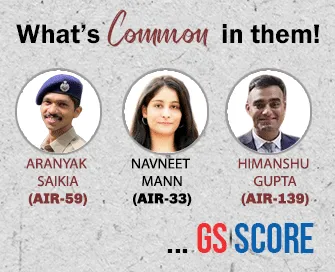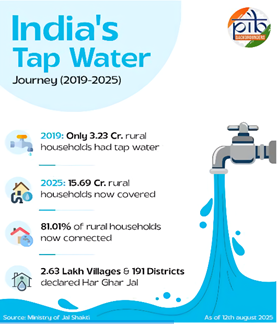

28th August 2025 (12 Topics)
Context:
The Government of India is considering the continuation of the Jal Jeevan Mission until 2028, after achieving over 15 crore rural household tap water connections.
Transforming Rural India through Har Ghar Jal
Introduction
- Launched on 15 August 2019, Jal Jeevan Mission (JJM) aimed to provide functional tap water connections to every rural household by 2024.
- At inception: only 23 crore out of 19 crore rural households had access.
- Current achievement (Aug 2025):15 crore+ households, covering over 81% rural India.
- The mission is proposed to be extended till 2028 with renewed focus on infrastructure quality and sustainability.
Objectives of JJM
- Universal access to safe and adequate drinking water.
- Reduce drudgery of women and ensure gender equity.
- Prevent waterborne diseases and improve health outcomes.
- Strengthen community ownership of water systems.
- Promote sustainability and source conservation.

Key Features and Enablers
- Decentralised and Community-Led Planning
- Village Action Plans (VAPs): designed by Gram Sabhas.
- Village Water & Sanitation Committees (VWSCs):29 lakh constituted for planning, implementation, O&M.
- Women’s Leadership
- 8 lakh+ rural women trained in water quality testing using Field Test Kits.
- Ensures scientific monitoring and grassroots ownership.
- Sustainability Measures
- Focus on water source sustainability and greywater management.
- Community responsibility for long-term maintenance.
- Digital Monitoring
- Geo-tagged data, mobile apps, and dashboards ensure real-time monitoring.
- Promotes transparency, accountability, and trust.
Impact of JJM
- Health Outcomes
- Decline in diarrhoea, cholera, and other waterborne diseases.
- Education & Gender Empowerment
- Girls attend schools regularly as water-fetching burden is reduced.
- Women participate in SHGs, farming, and microenterprises.
- Economic Upliftment
- Women save time and engage in income generation.
- Improved water access boosts local agricultural productivity.
- Social Inclusion
- Mission ensures coverage of marginalised and remote communities.
Challenges Ahead
- Ensuring quality and reliability of tap water supply.
- Operation and Maintenance (O&M): rural local bodies often lack technical and financial capacity.
- Groundwater depletion and climate-induced variability in sources.
- Sustaining behavioural change and community participation in the long term.
Way Forward
- Strengthen capacity of Gram Panchayats & VWSCs for O&M.
- Introduce water pricing and tariff models for sustainability without burdening poor households.
- Invest in water conservation structures (check dams, recharge wells, watershed management).
- Encourage public-private partnerships in rural water supply.
- Integrate JJM with Swachh Bharat Mission, MGNREGS, and Jal Shakti Abhiyan for holistic water management.
- Promote climate-resilient water infrastructure to handle variability in rainfall and drought-prone areas.
More Articles



